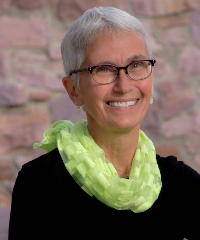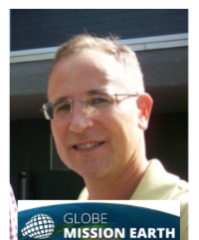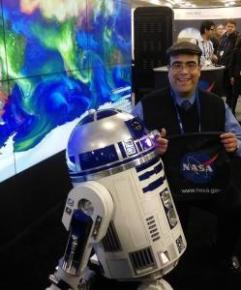GISN & STEM Professionals' Blog - GLOBE International STEM Network
GISN & STEM Professionals' Blog
The GISN and STEM Professional's Blog is an online collaborative effort where scientists associated with GLOBE post their thoughts, comments, and philosophies about a variety of science topics.
GLOBE strongly encourages positive and productive discussions to
further advance the scientific understanding of all involved with the
GLOBE Program.
Filter By:
Blogs List
The Problem
You've got a list of AOI coordinates. Google Maps will show them to
you, but it won't tell you the best order to visit them. If you’ve got
more than a few points, this becomes a mess—guesswork, wasted time,
and unnecessary backtracking.
We need a tool that will plan the most efficient route for us instead
of figuring things out ourselves. That’s what this does, here’s how:
The Solution
This problem is a textbook example of the classic Traveling
Salesman Problem (TSP): How can we find the shortest route
that visits each location (in our ...
Read More »
Posted in:
Curriculum:
TECHNOLOGY
STEM
GLOBE Science Topics:
EARTH AS A SYSTEM
Investigation Areas:
EARTH AS A SYSTEM
It was great seeing all of the data that students collected for the
Urban Heat Island Intensive Observation Period in December 2024. I
decided to look at some of the data using a graphing tool called CODAP
from the Concord Consortium. It is easy to use and makes some neat
graphs fast.
First, I downloaded all of the surface temperature data from the
GLOBE website for December using the ADAT system (Advanced Data Access
Tool). There are other ways to get data from the GLOBE data base
including the Vis system and API.
Second, I brought the data into CODAP and clicked on ...
Posted in:
Field Campaigns:
SURFACE TEMPERATURE
GLOBE Mission Earth News:
STUDENT RESEARCH & ACTIVITIES
GLOBE Science Topics:
GLOBE PROTOCOLS
SCIENTIST SKILLS
Investigation Areas:
SURFACE TEMPERATURE
La Nube is El Paso’s newest interactive science museum that opened
this August 2024, and GLOBE’s official partner, the El Paso Community
College (EPCC) and the Gene Roddenberry Planetarium provided fun and
educational activities for a Fall camp for middle schoolers. This
three-day camp provided interactive projects for these young students
to learn more about science. La Nube provided various interactive
demonstrations on atmospheric processes and desert environments. The
Gene Roddenberry Planetarium group headed by Evelyn Maldonado, an
official NASA Solar System ...
Posted in:
The El Paso Community College (EPCC) – Transmountain campus hosted
3rd Earth Science Day Event on October 16th with the main theme being
Earth Science Everywhere . The aim was to help the public
understand how weather, climate, natural resources and other
geological processes affect our everyday lives and decision making in
the El Paso region.
EPCC embarked on this event in tandem with the American Geosciences
Institute’s (AGI) annual Earth Science Week: a time designated to
promote geoscience awareness across our nation. Here is an excerpt on
AGI’s focus for this ...
Posted in:
Mis queridos lectores los invito a consultar el siguiente artículo
publicado este año por la revista Palobra de la Universidad de
Cartagena (Colombia).
https://revistas.unicartagena.edu.co/index.php/palobra/search/authors/view?givenName=Delimiro&familyName=Navarro%20Arrieta&affiliation=Instituci%C3%B3n%20Educativa%20de%20Gambote&country=CO&authorName=Navarro%20Arrieta%2C%20Delimiro
El cual permite difundir los resultados de un proyecto maravilloso en
el que la investigación dirigida es la estrategia pedagógica
implementada para potenciar las competencias ...
Posted in:
Curriculum:
EDUCATION RESEARCH
STEM
GLOBE International STEM Network (GISN):
GLOBE INTERNATIONAL STEM NETWORK (GISN)
GLOBE Mission Earth News:
STUDENT RESEARCH & ACTIVITIES
GLOBE Science Topics:
DATA INCLUDED
GLOBE PROTOCOLS
Investigation Areas:
HYDROSPHERE
This
project is all about mixing the personal stories of citizen
scientists with 30 years of the GLOBE (Global Learning and
Observations to Benefit the Environment) program. It combines
these two sources, as well as other data sources, to get a
complete picture of how our environment change
This
is the first year for the Climate Chronicle activity. Explore
th e collection of Climate
Chronicles from the 2024 virtual SEES Earth System ...
Posted in:
Our project for SEES 2024 was "Creating a Model to Identify
High-Risk Areas for Flash Flooding in Houston, Texas." In this
blog, I will discuss how we calculated which areas are "high-risk."
There are many ways to identify the most at-risk points of flooding
in a given region. Such points are commonly identified in a flood map,
such as the one here:
For our project, we decided to look at elevation data, which is
perhaps the most intuitive: water flows downhill and will accumulate
in the lowest regions. To get our elevation data, we used ...
Posted in:
GLOBE Science Topics:
CLIMATE CHANGE
EARTH AS A SYSTEM
EARTH SYSTEM SCIENCE
Investigation Areas:
EARTH AS A SYSTEM
BIOSPHERE
LAND COVER CLASSIFICATION
Primary Audience:
SCIENTISTS
STUDENTS
TEACHERS
Student Research Reports:
MISSION MOSQUITO REPORT
SEES 2024 Experience
Getting the opportunity to participate in the NASA SEES Earth System
Explorers program has positively impacted my educational and career
journey in more ways than I could've imagined. Throughout this
internship, I gained an immense amount of knowledge in Earth science,
utilizing the GLOBE Observer app, ArcGIS, Collect Earth Online,
Python, and many other tools to better understand the environment
around us. During the last few weeks of the program, a team of seven
other interns and I completed our own research project called
"Harnessing ...
Posted in:
GLOBE Science Topics:
EARTH AS A SYSTEM
Investigation Areas:
EARTH AS A SYSTEM
LAND COVER CLASSIFICATION
MOSQUITOES
Primary Audience:
SCIENTISTS
STUDENTS
TEACHERS
Student Research Reports:
MISSION MOSQUITO REPORT
In this blog post, I will go through every step of the internship and
outline my experience!
Before I do that, first of all, I would like to say that I am so
happy that I got to spend my summer with SEES! This program was so
amazing and helped guide me a bit more on what I want to do in my
future career and in college! I am very grateful for all of our
mentors who guided us through the program and provided great knowledge
and support to all of us! Thank you for this opportunity.
Modules: Climate Science Background and Exploring the Earth
To prepare for the ...
Posted in:
GLOBE Science Topics:
EARTH AS A SYSTEM
Investigation Areas:
EARTH AS A SYSTEM
LAND COVER CLASSIFICATION
MOSQUITOES
Student Research Reports:
MISSION MOSQUITO REPORT
If you had asked me what “citizen science” was before this internship
with the NASA SEES ( STEM Enhancement in Earth Science ) Earth System
Explorers, I most likely would have conjured a description that
involved studying the human body. Now, however, I feel confident in
saying that citizen science is a dynamic, extraordinary meaningful
process by which everyday citizens contribute to real-world scientific
research. This internship allowed me to take on the roles of both a
citizen scientist and a researcher, deeply engaging with my local
community and environment while ...
Posted in:
GLOBE Science Topics:
DATA INCLUDED
EARTH AS A SYSTEM
Investigation Areas:
EARTH AS A SYSTEM
Primary Audience:
PARTNERS
SCIENTISTS
STUDENTS
TEACHERS
Student Research Reports:
MISSION MOSQUITO REPORT
The wildfire data analysis journey began with a dataset comprising
over 1200 points located in the California region. To uncover the
correlation between land cover types and wildfire risk, we first
needed to determine the wildfire risk for each point using the FEMA
Wildfire Risk Map. This step involved entering coordinates into the
software to obtain the wildfire risk index for each location. From
this dataset, we categorized approximately 325 points as having a very
low risk, 350 as moderate risk, and 578 as very high risk for
wildfires. These categories served as the ...
Posted in:
GLOBE Science Topics:
EARTH AS A SYSTEM
Investigation Areas:
EARTH AS A SYSTEM
LAND COVER CLASSIFICATION
Primary Audience:
SCIENTISTS
STUDENTS
TEACHERS
Student Research Reports:
MISSION MOSQUITO REPORT
My group’s project focused on using land cover data and GLOBE
Observer images to create a machine learning model that can predict
land surface temperature - a measure of how hot the surface of the
Earth feels in a given location. For context, GLOBE is short for
“Global Learning and Observations to Benefit the Environment”. It’s an
app that lets volunteers across the world take observations of their
local community (these could be of cloud cover, land cover, or
mosquito habitats) and these observations help scientists track
changes in the environment. It’s part of a wider ...
Posted in:
GLOBE Science Topics:
EARTH AS A SYSTEM
Investigation Areas:
HYDROSPHERE
EARTH AS A SYSTEM
MOSQUITOES
Learning Activities:
EARTH AS A SYSTEM
LAND COVER/BIOLOGY
Primary Audience:
PARTNERS
STUDENTS
TEACHERS
Student Research Reports:
MISSION MOSQUITO REPORT
Roboflow is an open-source dataset management platform, where users
can import data, label it, and then have a model train on it. For my
group's project, CS-FLARE, we used Roboflow to label brush, grass,
trees, and leaf litter in our NESW Images as shown below.
When I initially began labeling images, I tried
using bounding boxes for each picture like the leaf litter in the
image above. This became a bit annoying as sometimes the bounding
boxes would cut parts of objects like trees, but it was still faster
than using the polygon tool to manually trace around objects. ...
Posted in:
Investigation Areas:
EARTH AS A SYSTEM
LAND COVER CLASSIFICATION
MOSQUITOES
Primary Audience:
STUDENTS
TEACHERS
Student Research Reports:
MISSION MOSQUITO REPORT
Check out these links to learn more on what we presented at the GLOBE
2024 annual meeting on the April 2024 eclipse!
English version: GLOBE_EPCC2024.mp4
Disponible en español: GLOBE
- EPCC Meeting Presentation 2024 (1).mp4
Posted in:
El 25 de septiembre de 2015, los líderes
mundiales adoptaron un conjunto de objetivos globales para erradicar
la pobreza, proteger el planeta y asegurar la prosperidad para todos
como parte de una nueva agenda de desarrollo sostenible. Cada objetivo
tiene metas específicas que deben haberse alcanzado para el año 2030.
Para alcanzar estas metas, todo el mundo tiene que hacer su parte: los
gobiernos, el sector privado, la sociedad civil y personas como
nosotros (ONU).
Es por esta razón que el encuentro de
hoy tuvo como propósito principal establecer con cuales de los 17 ...
Posted in:
Curriculum:
EDUCATION RESEARCH
GLOBE International STEM Network (GISN):
GLOBE INTERNATIONAL STEM NETWORK (GISN)
GLOBE Mission Earth News:
STUDENT RESEARCH & ACTIVITIES
GLOBE Science Topics:
CLIMATE CHANGE
Investigation Areas:
BIOSPHERE
Retomando nuevamente los encuentros luego de un corto período de
vacaciones de sus miembros.
En esta ocasión se plantearon varios interrogantes, con base en la
situación priorizada, para estructurar la pregunta de investigación a
la cual se le dará respuesta con el desarrollo de la investigación.
Posted in:
Curriculum:
EDUCATION RESEARCH
Field Campaigns:
CARBON CYCLE
GLOBE International STEM Network (GISN):
GLOBE INTERNATIONAL STEM NETWORK (GISN)
GLOBE Mission Earth News:
STUDENT RESEARCH & ACTIVITIES
GLOBE Science Topics:
CLIMATE CHANGE
Investigation Areas:
BIOSPHERE
El encuentro de hoy marca el inicio de la ruta de la investigación
compuesta por tres fases: (1) Planeación del Proyecto, (2) Desarrollo
de la Investigación y (3) Comunicación de Resultados. Se inicio con la
primera fase, específicamente identificando y priorizando la situación
problema en el contexto que será abordada.
Posted in:
Curriculum:
EDUCATION RESEARCH
GLOBE International STEM Network (GISN):
GLOBE INTERNATIONAL STEM NETWORK (GISN)
Investigation Areas:
BIOSPHERE
Los padres de familia tienen muchas maneras de participar en la
educación de sus hijos, entre ellas se encuentran el asistir a
reuniones de padres y maestros, participar en actividades escolares,
apoyar el aprendizaje en el hogar y comunicarse regularmente con los
maestros, ayudando a sus hijos a establecer metas académicas,
brindarles apoyo emocional y motivarlos a alcanzar su máximo potencial.
Y no solo eso, el hecho de que los padres participen activamente en
la educación de sus hijos, a través de las formas mencionadas
anteriormente, ayuda a que exista una mejor ...
Posted in:
Curriculum:
EDUCATION RESEARCH
GLOBE International STEM Network (GISN):
GLOBE INTERNATIONAL STEM NETWORK (GISN)
Investigation Areas:
BIOSPHERE
ONDAS es un programa de la Dirección de Vocaciones y Formación en Ciencia, Tecnología e Innovación, del Viceministerio de Talento y Apropiación Social, de MINCIENCIAS (Colombia), que busca que los niños, niñas, adolescentes y jóvenes colombianos se interesen por la investigación y desarrollen actitudes y habilidades para que encuentren en la Ciencia y la Investigación una pasión y un posible proyecto de vida (www.ondas.minciencias.gov.co).
Posted in:
Curriculum:
EDUCATION RESEARCH
STEM
GLOBE International STEM Network (GISN):
GLOBE INTERNATIONAL STEM NETWORK (GISN)
Investigation Areas:
BIOSPHERE
Welcome back!
Often times we still get nervous for the first day of classes. No matter if it’s as a child walking down the intimidating halls of school or as an adult wondering if the teacher will be good and the books not so expensive, those first moments or even days of school often can be daunting. As instructors, it’s our job to engage our students and make a good first impression so we can restart the curious minds in our class. For my case, the goal is to guide my student’s learning experience using GLOBE resources to better understand the branch of science known as physics. ...
Posted in:
—
20 Items per Page









